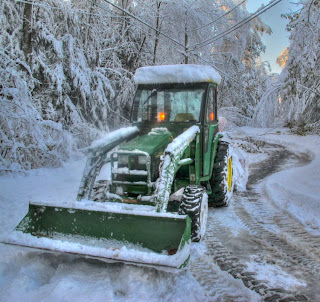What to do when you tangle your backhoe in the electric lines
This past weekend we had unprecedented damage from an early
snowstorm. Trees were down across all
the roads in town, and many took powerlines down with them. I had to clear a dozen or more large trees
just to reach the highway, less than half a mile from my house.
I used the front end loader on my tractor to break up the
tree jams, and pick up the brush and move it aside so cars could pass. Anyone who’s ever run a loader knows that’s
heavy and dangerous work as the trees bend and snap. You’re glad to be in a roll cage enclosed cab
with some of those limbs come back to whack you in the face!
To clearing the road I’d scoop under a load of tree debris,
lift it high, and dump it in the woods.
That process went along uneventfully until I picked up a load of brush
that was tangled with bare electric power lines. There are lots of stories online telling you to stay away from power lines. There are very few stories that talk about what you should do if you get up close and engaged with them. Today, I’d like to share my thoughts with you.
The conventional wisdom says that it’s fatal to contact live
electrical power lines. That is
certainly the case much of the time, but not always.
If you hit live power lines with a loader, backhoe, or
crane, and you are inside an enclosed cab on the machine, you can probably
emerge unscathed, provided you keep your wits about you and follow these
steps.
When your machine touches the line, it immediately becomes
energized to the voltage in the wires.
If you are sitting in the cab, you get energized too. You don’t actually feel anything but a
tingle, as no current is flowing through you, but you are suddenly in a very
dicey position.
As long as you remain in the cab, the wires can’t touch you,
and the current flows through the metal of the machine. If you get out of the cab, or a wire gets
in, all that changes. If you touch anything outside the cab, the power line current will flow from the cab frame, into you, and out of you into whatever you touch. That's almost always lethal.
That’s how most people who have accidents on construction
equipment get killed. They hit a line,
and then jump off the machine. That’s
usually a fatal error. The ground under
the machine is energized as the current flows through the wire, into the
machine, and into the surrounding earth.
The dirt within five to ten feet of the machine is going to be energized
to a dangerous level. So you can be safe
in the cab, but dead if you jump on the ground.
The wires present another danger. If the wire is outside, touching your loader frame,
you are safe. If the wire gets inside,
or touches you, you are toast. So don’t
open the windows or doors.
If anyone sees you in this fax, wave them away, but do not
open the doors. If they approach you,
they are likely to be electrocuted by the field you are currently immersed in. Hopefully, no one else is around you.
The final danger is that the energy in the wire will disable
the machine, leaving you unable to escape.
When the energy flows into the machine’s steel frame, it has to go
somewhere. That somewhere is ground,
through the steel tracks or rubber tires that the machine sits on. That point of contact with the ground becomes
a hot spot, both figuratively and literally.
A tracked machine, sitting on steel tracks, could have the grease in the
tracks burst into flame. A wheeled
loader will have smoke coming from the tires as they begin to melt. Both situations call for fast action.
Disengage the machine from the wires, look around for other
hazards, and back away. If the machine’s
arms are tangled, remember the rig has enough power to break the wires, but you
have to make sure you back clear, wherever they land. That is absolutely vital. Wires may be dark, and hard to see against
downed trees or a dark roadway. It’s
essential that you back at least twenty feet away from them before exiting the
cab. If the ground is wet, back farther.
If for some reason you cannot back away, remain in the cab
and use a cell phone or radio to call for help.
When seeking help, the only thing someone can do is cut the power
remotely. Any attempts to approach your
energized machine will be lethal to potential rescuers. It’s far better and safer to get your
machine out of danger under its own power.
Hopefully, you will never encounter powerlines in a
construction machine. If you do, just
remember. Stay inside. Keep your head. Disengage and back clear.
Once clear, flag the area as dangerous from a safe
distance. When walking near downed wires
it’s possible to step from an area with no charge to a lethally charged area with
no visible indication of what is about to happen. In that sense, downed lines are more
dangerous than the deadliest snake, because they do not even have to touch you
to kill you.


.jpeg)



Comments
That aside, what's a "safe distance" away from, say, 22kV wires on the ground, consisting of dirt and (wet) grass? 10 metres? 20 metres?
Does it change in areas where the soil is red because of large amounts of iron oxide?